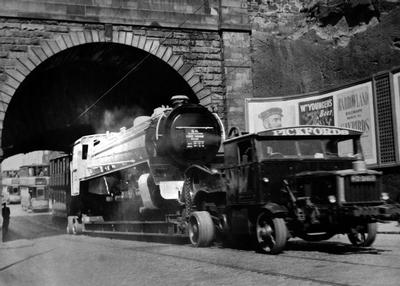
A locomotive being transported under the Forth and Clyde Canal at Rockvilla, 1955. Trams wait in line behind the slow-moving heavy load.
This aqueduct was built c 1880 to replace an earlier one of c 1790, which carried the extension of the Forth and Clyde Canal from Hamiltonhill to Port Dundas. It has a low, strong archway which carries the water channel (barely visible above the locomotive's cab) and two higher arches on either side which carry the canal towpaths. The locomotive was built by the North British Locomotive Co at the Hyde Park Works.
In 1883 a soldier found a tin hat box on the acqueduct. When he opened the box, it exploded and he suffered severe burns. The bomb was believed to have been planted by a member of Jeremiah O'Donovan Rossa's Skirmishers, an Irish-American self-proclaimed terrorist organisation that had planted bombs at Tradeston Gasworks and Buchanan Street Station, and went on to launch a bombing campaign in London.
In 1955 Partick Camera Club set out to create a photographic survey of Glasgow. As the project progressed, other camera clubs joined and each was allocated a district of the city to photograph. Glasgow Museums exhibited the photographs at Kelvingrove Art Gallery and Museum and at the People's Place, and in 1956 the exhibition was shown at the Palace of Art in Bellahouston Park. The photographs are now part of Glasgow Museums' collections.
Reference: 1005.97.299 / OG.1955.121.[242]
Reproduced with the permission of the Partick Camera Club
Keywords:
bombings, bridges, canals, Forth and Clyde Canal, Glasgow Photographic Survey 1955, Hyde Park Locomotive Works, Irish Americans, locomotives, lorries, North British Locomotive Co, O'Donovan Rossa's Skirmishers, Pickfords, terrorists, trams
You have 1 image in your photo album.